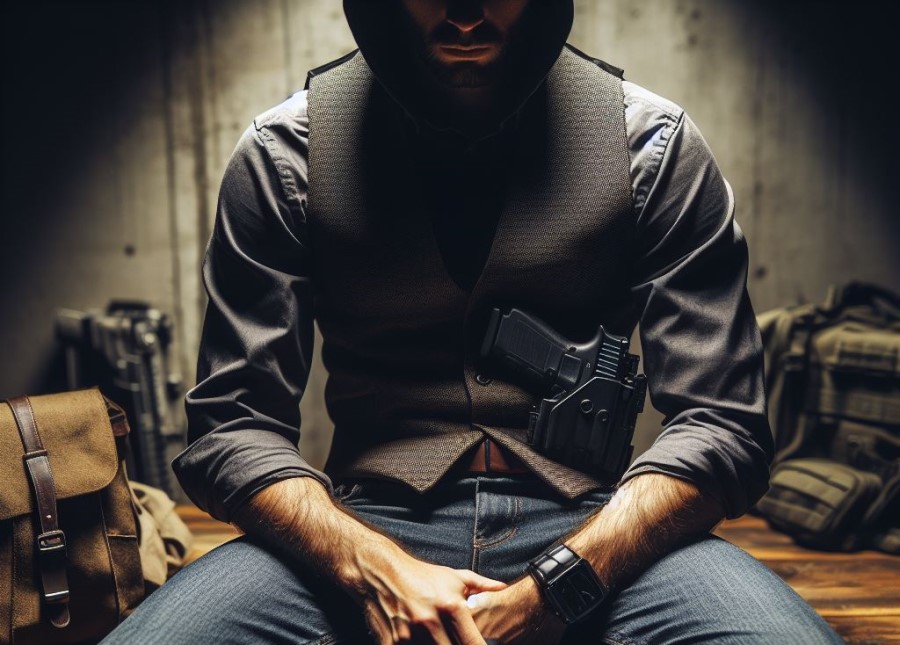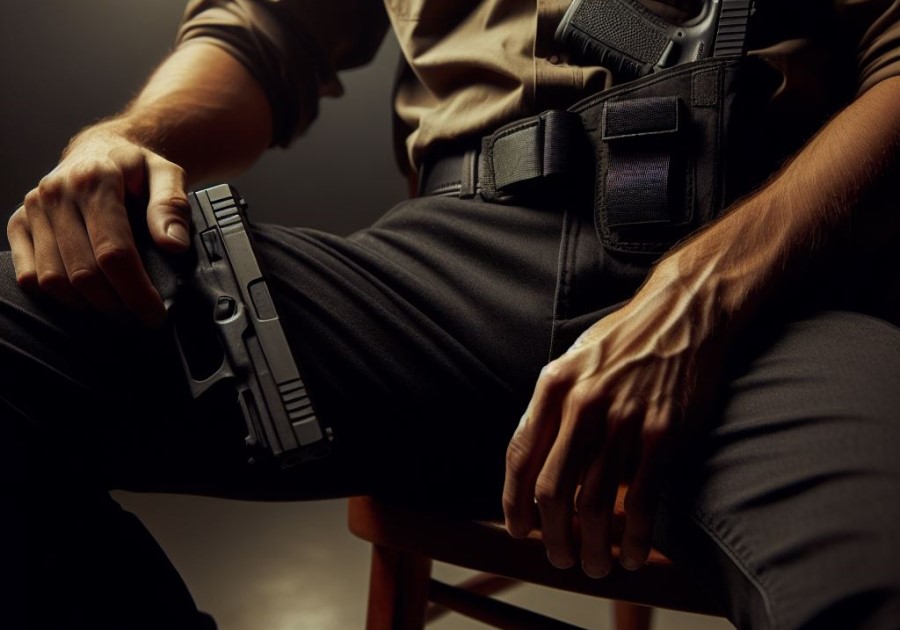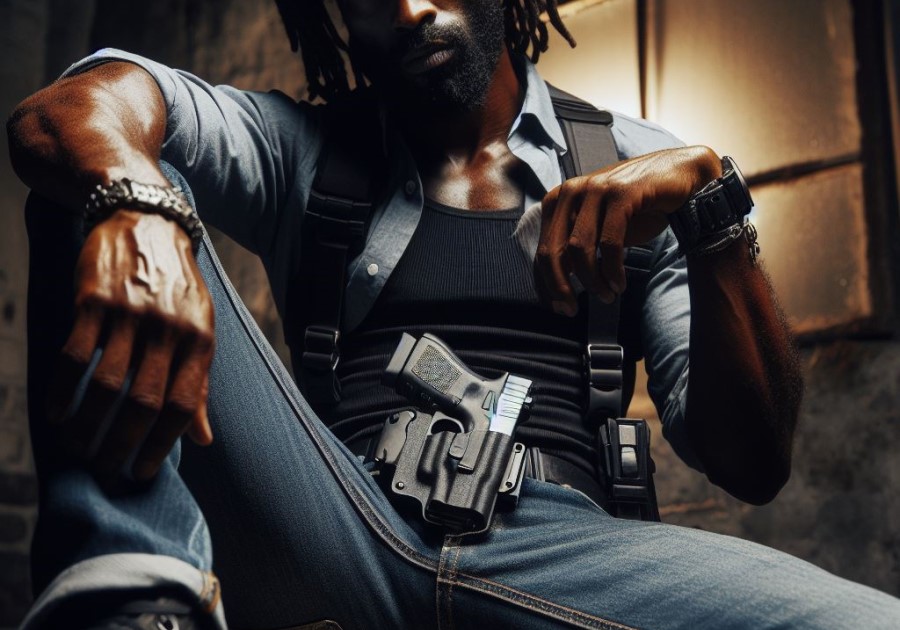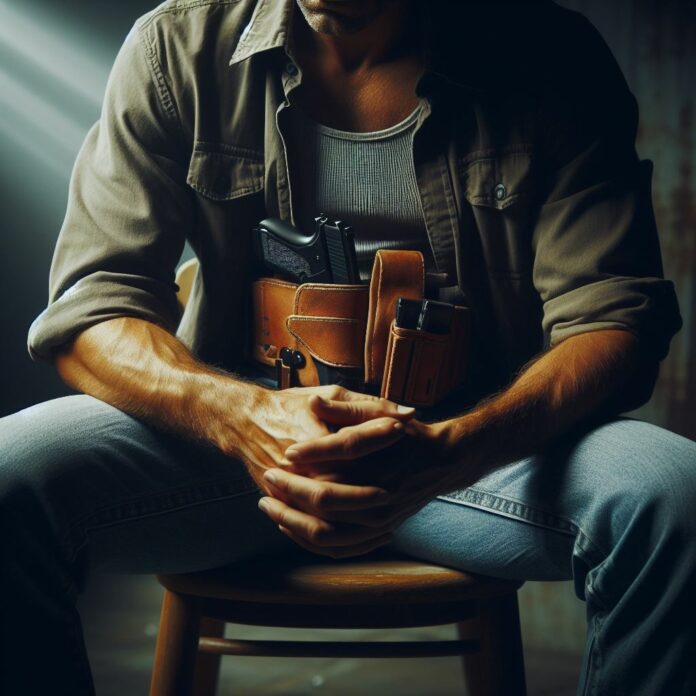People choose to use appendix holsters for various reasons, including their accessibility, potential for improved concealment, and ease of draw. However, when considering how to sit with an appendix holster, several crucial factors must be taken into account, including comfort and mobility, safety and concealment, as well as any legalities and regulations in the specific jurisdiction.
The safety of sitting with an appendix holster depends on several factors. While the appendix carry position offers advantages in terms of accessibility and concealment, it also presents risks and precautions to be aware of.
Adequate training and familiarity with the appendix carry position are vital to minimize potential risks. choosing the right holster that offers sufficient retention and trigger guard protection is crucial in ensuring safe use.
Alternatives to sitting with an appendix holster include exploring other carry positions that may offer better comfort and safety, such as strong-side hip carry or small of back carry. considering additional concealment options, such as clothing choices or accessories like concealment shirts, can provide added peace of mind.
While the concept of sitting with an appendix holster may seem appealing to some, it is essential to weigh the potential risks, personal comfort, and legal considerations before deciding to do so.
By understanding the factors involved and exploring alternative carry options, individuals can make an informed decision regarding appendix holsters and their suitability for sitting situations.
What is an Appendix Holster?

An appendix holster, also known as an appendix carry holster, is a specific type of gun holster specially designed to be carried in the appendix position.
This position is located on the front of the body, between the belly button and the hip.
Usually, this type of holster is attached to the pants’ waistband, providing easy and quick access to the firearm when required.
The appendix holster is highly favored by concealed carry enthusiasts due to its excellent concealability and comfort.
It enables a smooth and natural draw while ensuring the gun remains securely in place.
The most commonly used materials for constructing appendix holsters are kydex and leather.
It is crucial to emphasize that the use of an appendix holster demands proper training and practice to guarantee safe and efficient handling of the firearm.
It is always recommended to seek professional guidance when utilizing any type of holster to ensure both the right usage and firearm safety.
How Does an Appendix Holster Work?
- An appendix holster functions by being worn in the appendix carry position, which is situated around the front of the body, just off the centerline.
- Typically constructed from durable materials such as polymer or leather, the appendix holster securely holds the gun in place.
- Positioned inside the waistband, the holster has the gun grip facing towards the body, allowing for easier access.
- To ensure a secure fit, the appendix holster is attached to a belt using various systems, such as a row of button snaps or a ratchet system.
- Designed specifically for busy environments, the appendix holster provides a comfortable and concealable option for carrying a handgun.
- When seated, the holster accommodates the body’s movements, enabling the wearer to maintain a comfortable seated position.
- Some appendix holsters incorporate additional features, such as a muzzle wedge or a row of shock cord, for added stability and a faster draw.
- Choosing the right size and design of holster is crucial to ensure it fits both the gun and the individual’s body shape.
- Appendix holsters are preferred by law enforcement officers and individuals engaged in plainclothes work due to their slightly better concealment.
Why Do People Use Appendix Holsters?
People use appendix holsters for various reasons. One of the main reasons is that appendix carry allows for quicker access to the firearm, especially in situations that require a fast draw.
The holster is strategically positioned in front of the body, making it easily accessible with the dominant hand. Furthermore, appendix holsters offer slightly better concealment compared to other carrying positions because the firearm is located in front of the body and can be easily concealed by clothing.
Another reason why people choose appendix holsters is the comfort and mobility they provide. The slim design of the holster and its placement on the body allow for freedom of movement, making it suitable for everyday carry. The appendix position also ensures that the firearm remains securely in place even when bending over or in busy environments.
Additionally, appendix holsters are widely preferred by law enforcement and plainclothes officers who need to carry concealed. The holster’s position enables a faster draw and allows for the attachment of a spare magazine carrier, ensuring that the officer is fully prepared.
To ensure the safe and effective use of an appendix holster, it is crucial to undergo proper training and become familiar with the holster. Furthermore, selecting the right holster and belt options, such as a polymer core leather gun belt or a Cobra® quick release gun belt, can further enhance comfort and stability.
So, why do people use appendix holsters? They appreciate the accessibility, improved concealment, comfort, mobility, and practicality these holsters offer, especially in crucial situations requiring quick and efficient firearm use.
Considerations Before Sitting with an Appendix Holster

When it comes to sitting with an appendix holster, there are important considerations that shouldn’t be overlooked. In this section, we’ll explore the factors that play a role in making this decision.
From the comfort and mobility aspect to the crucial matter of safety and concealment, we’ll delve into what you should keep in mind. We’ll also touch on the legalities and regulations surrounding the use of appendix holsters. So, before you make a choice, let’s dive into the essential details to ensure you’re well-informed.
Comfort and Mobility
When it comes to comfort and mobility, here are some important factors to consider while using an appendix holster:
- Fit: The holster should fit securely and comfortably around your waist, allowing for easy movement without shifting or sliding.
- Material: Choose a holster made from high-quality, durable materials that won’t cause discomfort or irritation against your skin.
- Adjustability: Look for a holster with adjustable features such as belt clips or straps, allowing you to customize the fit and position for maximum comfort and mobility.
- Concealment: Ensure that the holster’s design and positioning provide effective concealment while sitting, so that it doesn’t print through your clothing or cause any discomfort.
The use of appendix holsters for concealed carrying is a contemporary practice that has gained popularity in recent years due to its advantages in comfort and mobility. By positioning the holster in the front of the body, it offers easier access to the firearm, especially for individuals with dominant hands.
This method also allows for a faster draw and better retention of the gun. While appendix carry may not be suitable for every individual or every situation, it has become a preferred carry position for many law enforcement officers and individuals in plainclothes work.
With advancements in holster design and the availability of various belt and holster options, sitting with an appendix holster can now provide slightly better concealment and ample mobility and comfort without compromising comfort and mobility.
Safety and Concealment
When using an appendix holster, it is crucial to incorporate certain factors that promote safety and concealment.
- One of the key aspects to consider is proper gun retention. A top-notch holster should securely hold the firearm in place, reducing the risk of accidental dislodging or unauthorized access.
- In terms of trigger protection, the design of the holster should completely cover the trigger guard. This ensures that there are no chances of any unintentional discharges.
- Concealment is another significant factor, and the appendix carry position provides better concealment due to its placement in the front of the body. This positioning facilitates easier concealment of the firearm under clothing.
- To ensure comfort and accessibility, it is vital that the holster is designed to be comfortable for extended periods of wear and allows for easy access to the firearm in times of need.
- Proper training and familiarity with the specific holster model are also essential. It is crucial to practice appropriate drawing and reholstering techniques to ensure safe handling of the firearm.
By considering these important aspects, individuals can enhance safety and achieve better concealment when using an appendix holster.
Legalities and Regulations
When it comes to sitting with an appendix holster, it is crucial to consider the legalities and regulations associated with carrying firearms in your jurisdiction:
- Concealed Carry Laws: Familiarize yourself with the concealed carry laws in your specific area. Different regulations may apply to carrying firearms in different positions.
- Permits and Licensing: Before carrying a concealed firearm, make sure you possess all the necessary permits and licenses required by law. Non-compliance with these regulations can lead to legal consequences.
- Duty to Inform: In certain jurisdictions, individuals may be required to inform law enforcement officers about their concealed weapon during interactions. It is crucial to be aware of and follow these requirements.
- Restricted Areas: Some locations, such as government buildings, schools, or airports, may enforce restrictions on carrying firearms. Familiarize yourself with these designated areas and comply with the applicable regulations.
- Safe Handling and Storage: It is of utmost importance to handle and store your firearm safely at all times, regardless of whether you are carrying it. By adhering to proper safety measures and practicing responsible gun ownership, you can avoid legal complications.
Always remember to stay well-informed about the legalities and regulations surrounding carrying firearms, including appendix holsters, in your specific area.
If you require further clarity on these matters, consider consulting with local authorities or legal professionals.
Can You Safely Sit with an Appendix Holster?

Safely sitting with an appendix holster is a crucial consideration for those who carry concealed firearms. In this section, we’ll explore the potential risks and precautions associated with appendix holsters.
We’ll also discuss the importance of proper training and familiarity when using this type of holster. Additionally, we’ll delve into the factors to consider when choosing the right holster for safe and comfortable appendix carry.
So, let’s dive in and ensure we’re equipped with the knowledge to make informed decisions about sitting with an appendix holster.
Risks and Precautions
Make sure to consider the risks and take necessary precautions when using an appendix holster. It is crucial to ensure that the holster is properly secured and fits securely around your waist to avoid any potential risks.
Be mindful of the possible discomfort or injury that may occur if the holster digs into your stomach or pelvic area while seated. Choosing a holster with proper padding or support can help mitigate these risks.
Take into account the clothing you wear while sitting with an appendix holster. Avoid wearing tight pants or belts that can create pressure or restrict movement, making it uncomfortable to sit for extended periods of time.
Exercise caution when bending over or getting up from a seated position to avoid any unintended visibility or accidental discharge. The position of the holster may cause the grip of the gun to become exposed, increasing the risks involved.
It is crucial to ensure that the holster design allows for an easy and repeatable draw, providing quick and efficient access to the firearm. Opt for a holster that is user-friendly and avoids complications or cumbersome features that may hinder your ability to retrieve the weapon swiftly if needed.
Training and Familiarity
When it comes to carrying a concealed firearm in an appendix holster, training and familiarity are crucial. It is essential to receive appropriate training on how to safely and effectively use an appendix holster. This training should include firearm safety, drawing and reholstering techniques, and situational awareness.
- Proper Training: It is essential to prioritize training in order to safely and effectively use an appendix holster. This includes firearm safety, drawing and reholstering techniques, and situational awareness.
- Familiarize Yourself: Take the time to become familiar with your specific appendix holster. Practice drawing and reholstering your firearm to build muscle memory and ensure a smooth and efficient motion.
- Practice Makes Perfect: Regular practice is crucial to maintain proficiency with your appendix holster. Regularly practice drawing and reholstering your firearm to improve your speed and accuracy.
- Comfort and Fit: Ensure that your appendix holster is comfortable to wear for extended periods. Consider the materials used, adjustability features, and how it conforms to your body shape.
- Concealment Considerations: The appendix carry position offers slightly better concealment than other positions, but it also requires careful attention to clothing choices to prevent printing or exposing your firearm. Experiment with different clothing options to find what works best for you.
By prioritizing training and familiarity with your appendix holster, you can confidently and safely carry your concealed firearm in this position.
Choosing the Right Holster
When it comes to choosing the right holster for your needs, there are several important factors to consider. First and foremost, you need to think about the type of gun you will be carrying. Different holsters are specifically designed to fit certain gun models, so it’s crucial to ensure that the holster you select is compatible with your firearm.
Another crucial consideration is your desired carry position. You must determine where on your body you wish to carry your gun. Commonly used positions include the appendix carry, strongside carry, and the 3 o’clock position.
Additionally, your clothing choices should influence your holster decision. Take into account the types of clothes you typically wear. If you regularly wear tight pants or have specific clothing restrictions, you may require a holster that provides better concealment.
Comfort and mobility are also essential aspects to think about. It’s important to find a holster that allows you to move freely and sit comfortably while still maintaining easy access to your firearm.
Safety and retention mechanisms are also of utmost importance. You need to ensure that the holster has proper retention mechanisms to securely hold your gun in place and prevent any accidental dislodging.
Don’t forget about the quality and durability of the holster. Opt for a holster made from high-quality materials that will be able to withstand daily use and provide long-lasting reliability.
Finally, some holsters offer extra concealment options. These can include features like adjustable cant or specialized holster designs that enhance concealment.
By taking all of these factors into account, you can confidently select the right holster for your needs.
Alternatives to Sitting with an Appendix Holster
Looking for alternatives to sitting with an appendix holster? Let’s explore other carry positions and additional concealment options in this section. Discover different ways to effectively and discreetly carry your weapon, ensuring both comfort and safety.
So, whether you’re seeking a more comfortable option or need alternative concealment methods, we’ve got you covered. No need to limit yourself to just one option when it comes to carrying your firearm securely.
Other Carry Positions
When it comes to carrying a concealed weapon, there are various positions to consider to ensure comfort, concealment, and easy access to your firearm. Here are some alternative carry positions:
- 1. Strongside Carry: This involves carrying the firearm on your dominant side, usually at the 3 o’clock position. It offers a familiar and easily accessible draw, making it a popular choice for many.
- 2. Pocket Carry: If you prefer a more discreet option, pocket carry involves placing the firearm in a pocket holster in your pants or jacket pocket. It provides good concealment but may limit the size of the firearm you can carry.
- 3. Ankle Carry: This position involves carrying the firearm in an ankle holster. It offers a concealed carry option that is easily accessible by simply lifting your pant leg. However, it can be less comfortable for extended periods of time.
- 4. Shoulder Holster: A shoulder holster allows you to carry your firearm under your arm, providing excellent concealment under a jacket or coat. It offers a comfortable carry option, especially for individuals who spend a lot of time sitting down.
- 5. Appendix Carry: While we are discussing other carry positions, the appendix carry is worth mentioning. It involves carrying the firearm in the front of your body, between the belly button and hip bone. It provides a comfortable and easily accessible draw but may require careful consideration of clothing choices and body shape.
Additional Concealment Options
When it comes to concealed carry, there are several additional concealment options you can consider:
- Shoulder holsters: These holsters are worn under the armpit, allowing for easy access to the firearm while providing good concealment under a jacket or coat.
- Ankle holsters: Additional concealment options are strapped around the lower leg, providing concealment and accessibility, especially for smaller firearms.
- Pocket holsters: Designed specifically for carrying in a pocket, these holsters keep the firearm securely in place while reducing printing.
- Deep concealment holsters: These holsters are designed to be worn deep inside the waistband or on the thigh for maximum concealment.
- Belly band holsters: These holsters are worn around the waist and can be adjusted to fit different body sizes. They provide flexibility in carry position and can be easily concealed under clothing.
Consider your comfort, body type, and the type of clothing you typically wear when choosing additional concealment options. Experiment with different options to find the one that works best for you in terms of comfort, accessibility, and concealment.
Remember, it’s important to prioritize safety and follow all legal regulations when carrying concealed. Practice proper firearms training and familiarize yourself with your chosen holster for a safe and secure carry experience.
By exploring these additional concealment options, you can find the best method that suits your needs and preferences.
Frequently Asked Questions
Can you sit comfortably with an appendix holster?
Yes, sitting comfortably with an appendix holster is possible, but it may depend on various factors such as the holster design, belt type, and pant choice. It is recommended to adjust the position of the carry to ensure easy accessibility when sitting for long periods of time. Additionally, investing in a comfortable concealed carry holster and wearing a proper gun belt can help distribute the weight and minimize discomfort.
Which holster is recommended for appendix carry with a Glock 19X?
For appendix carry with a Glock 19X, popular holster options include the AGIS Elite holster and the AXIS Elite holster. These holsters are designed for comfortable and secure appendix carry, providing easy concealment, quick draw, and accessibility. It is important to choose a holster that fully encloses the trigger guard and offers additional features like a wedge or claw for enhanced comfort and concealment.
What is the recommended belt for appendix carry?
When appendix carrying, it is important to choose a rigid and sturdy belt that can support the weight of the gun and holster. The EDC Belt from Kore Essentials is a recommended option for comfortable appendix carry. This belt provides excellent stability and adjustability to ensure a secure fit for your holster and gun.
Is the Haley Strategic Incog holster suitable for appendix carry?
Yes, the Haley Strategic Incog holster is a popular choice for appendix carry. This holster offers a sleek and low-profile design that is specifically designed for appendix carry. However, personal comfort and preference may vary, so it is essential to try different holsters and positions to find the one that works best for you.
What pant size should I consider for appendix carry?
When carrying inside the waistband, especially with an appendix holster, it may be necessary to increase your pant size to accommodate the gun and holster comfortably. Stretchy pants are recommended as they provide flexibility and ease of movement. It is important to ensure that the pants are not too tight or stiff, as this can cause discomfort and affect concealment.
What are the advantages of appendix carry?
Appendix carry offers several advantages, including better concealment, faster draw from concealment, and easier access in a vehicle. The draw from the appendix position is more efficient and eliminates the need for the elbow to travel behind the body. Additionally, appendix carry allows for a smoother and faster draw, making it a preferred method for many concealed carry enthusiasts.

